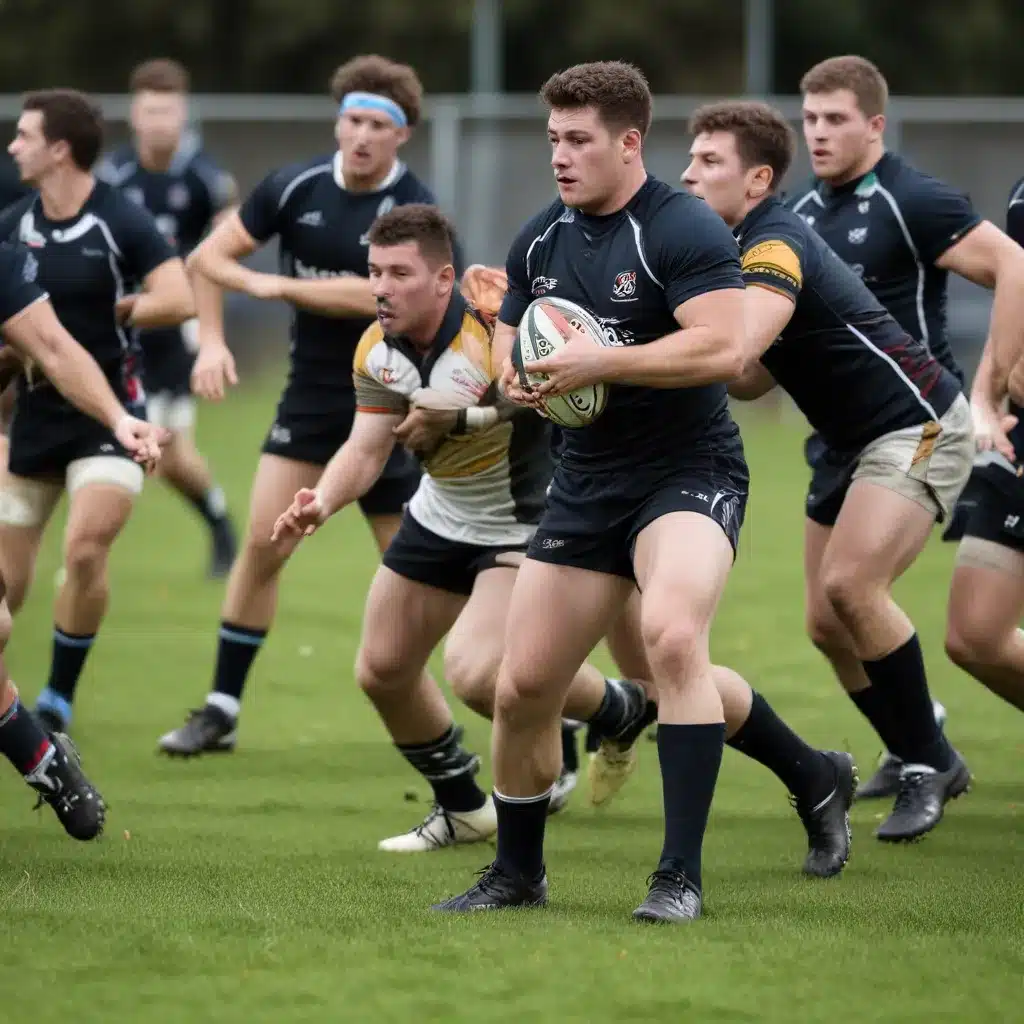
Developing Rugby Passing Accuracy: Drills for Elite-Level Distribution
Rugby Passing Fundamentals
As a seasoned rugby professional, I know that the ability to accurately and effectively distribute the ball is paramount to success on the pitch. Passing is a core technical skill that underpins much of the dynamism and creativity in our sport. Whether it’s hitting a supporting runner in stride, finding space out wide, or threading the needle through a crowded defensive line, pinpoint passing can turn half-breaks into clean linebreaks and set the conditions for your team to thrive.
The fundamentals of passing start with grip and stance. Players should grip the ball firmly with their fingers spread across the surface, aligning their shoulders perpendicular to the target. The non-throwing hand provides stability and control as the ball is drawn back. From there, it’s all about smooth, efficient throwing mechanics – a slight hip rotation, a fluid arm swing, and a snap of the wrist to launch the pass with velocity and accuracy.
Achieving elite-level passing distribution requires diligent, targeted practice. Merely going through the motions of passing drill after passing drill won’t cut it. You need to consistently focus on the key technical elements, receive detailed feedback, and make incremental adjustments until the movement becomes second nature.
Developing Passing Accuracy
One of the most effective ways to hone passing accuracy is through carefully designed, progressive passing drills. Start with simple, stationary drills to reinforce proper technique, then gradually increase the complexity and realism as players become more comfortable.
For example, set up a series of cones at varying distances and have players make short, crisp passes from a standstill, focusing on a clean catch-and-release motion. Once they demonstrate proficiency, progress to longer passes, angled throws, or passing on the move. Incorporate defenders to force quicker decision-making and tighter delivery under pressure.
Provide constant feedback throughout these drills, both verbal and visual. Highlighting specific technical points, such as elbow position, ball trajectory, or foot placement, can help players ingrain the right muscle memory. Video analysis is also invaluable, allowing players to see where they’re succeeding or falling short and make the necessary adjustments.
The key is to create a learning environment that is challenging yet achievable. Drills should be designed to push players just beyond their current abilities, fostering continued growth and improvement. Celebrate small victories, acknowledge areas for improvement, and keep the sessions dynamic and engaging.
Drill Progressions for Improved Distribution
Beyond basic accuracy, developing elite-level passing distribution requires a more comprehensive approach. Here are some drill progressions to help your players expand their passing repertoire:
Stationary Passing Drills
– Short-Range Passing: Set up a linear passing sequence with players spaced 5-10 meters apart. Focus on crisp, accurate deliveries and clean catches.
– Long-Range Passing: Increase the distance between players, challenging them to generate more power and trajectory control on their passes.
Dynamic Passing Drills
– Passing on the Move: Incorporate movement, such as lateral shuffles or angled runs, into your passing sequences. This replicates the dynamism of the game and tests players’ ability to deliver accurate passes while in motion.
– Passing under Pressure: Add defenders to disrupt the passing flow, forcing quicker decisions and tighter execution. Progression could involve a “shadowing” defender, an active “closing down” defender, or a full live contact drill.
The key to these drill progressions is to gradually increase the complexity and realism, ensuring players are consistently challenged to expand their passing repertoire. Supplement these drills with video analysis, individual feedback, and plenty of repetition to help players develop both the technical proficiency and the decision-making nous to become elite-level distributors.
The Importance of Elite-Level Passing
Developing exceptional passing accuracy and distribution is critical for success at the elite level of rugby. Precision passing unlocks a world of tactical advantages for your team:
Ball Retention: When players can consistently deliver the ball accurately to their intended targets, it minimizes turnovers and keeps possession. This allows your team to control the tempo of the game and wear down the opposition.
Offensive Opportunities: Pinpoint passing creates space and exploits defensive misalignments, setting the stage for clean line breaks, offloads, and try-scoring chances. The ability to hit a runner in stride or find an open teammate downfield is a game-changer.
From a performance metrics standpoint, elite passers will boast impressive stats: high pass completion rates, significant average gain per pass, and a low turnover percentage. These numbers don’t lie – the best distributors are invaluable assets to their teams.
Integrating Passing Drills into Training
Integrating passing drills into your overall training program requires careful periodization and programming. During the competitive season, the focus should be on maintenance – reinforcing the technical elements through short, targeted sessions to keep skills sharp.
In the offseason, you can dedicate more time to developing passing prowess. Incorporate a variety of drills, from the basic to the advanced, and gradually increase the intensity and complexity as players adapt. Emphasize both the technical and the tactical aspects of passing, fostering not just execution but also decision-making.
Resist the temptation to rely on the same old passing drills, week in and week out. Continually seek out new ideas, tweak existing drills, and challenge your players in novel ways. Variety keeps things fresh and encourages them to stay engaged and focused.
Remember, elite-level passing doesn’t happen overnight. It’s the product of tireless, deliberate practice, meticulous attention to detail, and a deep understanding of the game. Embrace the process, celebrate the small wins, and watch your players elevate their distribution skills to new heights.
